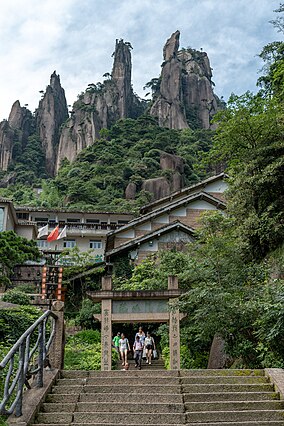Mount Sanqing
| Sanqingshan National Geopark | |
|---|---|
 | |
| Location | Jiangxi, China |
| Nearest city | Shangrao |
| Coordinates | 28°54′57″N 118°3′52″E / 28.91583°N 118.06444°E |
| Area | 229.5 km² |
| Established | 2005 |
| Official name | Mount Sanqingshan National Park |
| Criteria | Natural: (vii) |
| Reference | 1292 |
| Inscription | 2008 (32nd Session) |
| Area | 22,950 ha (56,700 acres) |
| Buffer zone | 16,850 ha (41,600 acres) |
Mount Sanqing (
A Chinese phrase “三峰峻拔、如三清列坐其巅” (“Three steep peaks, like the Three Pure Ones sit the summits”) explains why it was named San Qing. Amongst the three hills, the Yujing hill (1817 meters above sea level) is the highest.
Mount Sanqing is the highest of the Huaiyu Mountains and is known for its outstanding scenery and unique geological formations.[1] The area became a National Geopark in 2005, and a UNESCO World Heritage Site in 2008.[2][3] It is a famous tourist destination as well as a refuge for animals and plants. The national park contains more than 2300 species of plants and 400 species of vertebrates.[4] The total area of Mount Sanqing is 229 km².
Geological History and Hydrology
Mount Sanqing is a granite mountain that forms a part of a
Biodiversity
Located in a
Flora
There are many vegetation types in Mount Sanqing, including evergreen broad-leaved forests, warm temperate coniferous forests, warm temperate needle and broad-leaved mixed forests, bamboo forests, temperate needle and broad-leaved mixed forests, evergreen and deciduous broad-leaved mixed forests, coppice forests, and mountain top meadow coppice forests.[4] This, coupled with the isolated topography of the region and its status as an Ice-Age refugium, has allowed high rates of floral biodiversity and endemism.[4] Mount Sanqing protects many conifer species in particular, including rare varieties of Pseudotsuga sinensis gaussenii and Tsuga spp.[4] 19 of the plants found in the park were listed on the IUCN Red List as of 2003.
Fauna
Because of the large elevational gradients on and around the mountain and the corresponding variation in habitat, the fauna of the region display clear
Gallery
-
Map of the site
-
Cable car
-
Pine tree on a mountain top
-
The San Qing temple
-
Snake rock
-
South slope of Sanqingshan in fog
-
Sanqingshan's Longevity Garden in fog
-
Sunrise at Sanqingshan, with the Giant Python Emerging from the Mountain
References
- ^ a b "Mount Sanqingshan National Park". UNESCO World Heritage Centre. United Nations Educational, Scientific, and Cultural Organization.
- ^ "Sanqingshan Geopark". Global Geoparks Network. Retrieved 8 February 2015.
- ^ Canadian fossil park, an Icelandic volcanic island and archipelago in Yemen among sites added to UNESCO World Heritage List
- ^ a b c d e f g h i j Mount Sanqingshan National Park (PDF) (Report). Ministry of Construction of People’s Republic of China. Retrieved 11 Apr 2021.





















